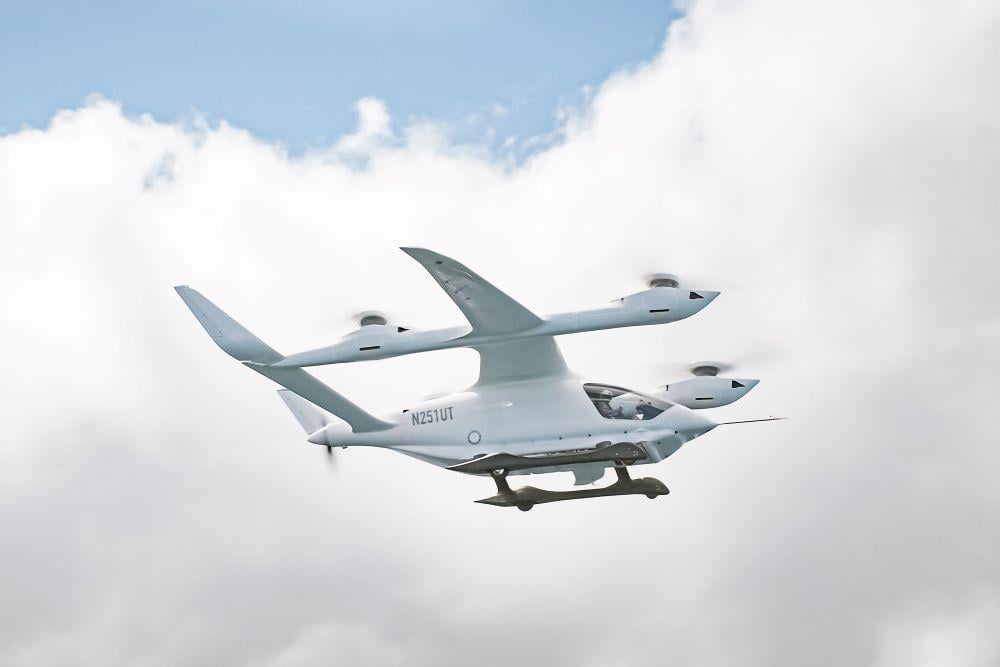See us at MRO Asia Pacific 2025
AFWERX Says Agility Prime eVTOLs Lack Range, Shifts To Hybrid
Details
More Products & Services
Products & Services
Home - Aviation Group Marketing
Aviation Week Network
120 data points on over 156,000 commercial and business aviation aircraft, including military transports. Discover the most trustworthy resource for the complete aircraft history, plus ad hoc reports, month-over-month trend analysis and details on expected deliveries through 2050.
Aerospace | Aviation Week Network
Aviation Week Network
https://aviationweek.com/themes/custom/particle/dist/app-drupal/assets/awn-logo.svg
People

Andrea Rossi Prudente
Aviation Week Network

Becca Balmes
Aviation Week Network

Belinda Tan
Aviation Week Network

Brian Everstine
Aviation Week Network
Editor

Eddie Krankowski
Aviation Week Network
Assistant Manager, Tradeshows

erving dockery
Aviation Week Network

Lisa Tan
Aviation Week Network
Senior Marketing Manager

Mark Thomas
Aviation Week Network
Description
In a significant shift of its strategy, the U.S. Air Force's AFWERX Agility Prime program has acknowledged that the battery-powered electric-vertical-takeoff-and-landing (eVTOL) aircraft it has been funding and testing over the past four years lacks the range necessary to be useful over the vast reaches of its operational theaters, such as across the Pacific Ocean.
“We're always balancing priorities and budgeting, but certainly the future is going to be in hybrid systems,” Prime Division Chief Lt. Col. Jonathan Gilbert told Aviation Week on Dec. 13. Hybrid eVTOL aircraft would give the Air Force the additional range and payload capacity needed for the service's logistics, he says.
AFWERX does not have any specific requirements, a program of record, or impending contracts for hybrid eVTOLs, Gilbert says. Instead, the Agility Prime accelerator program would look to piggyback on the existing hybridization efforts of commercial eVTOL developers, he says.
Developers of eVTOLs have typically designed their battery-powered aircraft with short range air taxi operations in mind. But at least two eVTOL developers, Beta Technologies and Archer Aviation, have said this month that they are developing hybrid aircraft for military missions.
Beta has two hybrid eVTOL aircraft in development, Kyle Clark, founder and chief executive of Beta Technologies, told Aviation Week on Dec. 16. The company has flown its ALIA A250 eVTOL with a reciprocating engine-powered range-extension kit installed in its cargo area multiple times since fall 2023.
The diesel-fueled generator was developed to validate hybridization engineering and design work for the ALIA. But Clark says the system could be sold in the future as a range-extender kit that would allow the battery-powered aircraft to ferry itself in conventional-take-off-and-landing (CTOL) mode–flying on its wing using its pusher propeller–more than 3,000 mi. The range extender is mounted to a cargo pallet and plugs into the aircraft's electrical power. A standard cargo door is swapped out for a door with an intake for aspiration and cooling, as well as an exhaust port.
The range extension kit could allow the U.S. military to self-deploy an eVTOL, says Clark, who notes the equipment also has a ground-based function. “That whole system comes out and becomes a generator on the ground to charge the aircraft.”
Beta is also developing a turbogenerator version of its ALIA that would provide power through all modes of flight, including vertical takeoff and landing (VTOL). The company says it has adapted a turbine typically used for low-altitude helicopters into a turbogenerator.
The startup has developed its own electromagnetic generators, controllers and has integrated the hybrid system into the nose of the ALIA. The company declines to say specifically where in the aircraft's nose the turbogenerator is located, but says the location was chosen for cooling and aspiration reasons. Exhaust comes out of the non-passenger and cargo side of the aircraft. Fuel is stored in the ALIA's wing.
The turbo-electric ALIA would have a 500-mi. range, including military reserves, when carrying 2,000 lb. of payload, Clark says. Beta is ground testing the aircraft ahead of a planned first flight.
Beta has “hybrid-related contracts with AFWERX and [U.S. Army Combat Capabilities Development Command] to support the development and testing of hybrid concepts,” Clark says. The contracts are to deliver test data and report other information to the branches, he says.
Beta's disclosure comes after Archer Aviation and Anduril Industries said on Dec. 12 that they had signed a “strategic partnership” to develop “next-generation aircraft” for defense applications starting with joint development of a hybrid-eVTOL aircraft for a potential U.S. Department of Defense program. The hybrid-eVTOL aircraft would be developed using Archer Aviation's eVTOL expertise and existing commercial parts and supply chains, as well as Anduril's expertise in autonomy, artificial intelligence (AI), military missionization and systems integration, the partners said.
Archer's Midnight eVTOL air taxi, designed primarily to shuttle passengers from downtowns to airports, has a range of 100 mi. Performance and the configuration of Archer's hybrid eVTOL were not disclosed, and the company declined to elaborate beyond its initial announcement.
Archer's hybrid eVTOL development project will be run within the company's new Archer Defense program. “To support this initiative and for other general corporate purposes, Archer raised $430 million in additional equity capital,” Archer says.
Joseph Pantalone will lead the Archer Defense unit as head of advanced projects. Pantalone worked from 2020 to November as Sikorsky's director of special programs and operations analysis.
Joby Aviation, another prominent air taxi developer and participant in the Agility Prime program, did not respond to a request for comment about its interest in hybrid eVTOLs. The company is developing hydrogen fuel cell technology as a means to extend eVTOL range and in July demonstrated a preproduction prototype version of its S4 flying 523 mi. using liquid hydrogen and a fuel cell.
Air Force generals have repeatedly stressed the logistical challenges of resupplying forces across the Pacific theater, noting the “tyranny of distance.” The service's leadership has also chosen a dispersion strategy, called Agile Combat Employment, to prevent its aircraft from being wiped out all out once while on the ground by missile attacks from China. But spreading aircraft across landing strips on islands across the Pacific Ocean makes the U.S. Air Force's logistics challenges more difficult.
AFWERX hopes that new smaller aircraft could help reduce the Air Force's reliance on its workhorse Lockheed Martin C-130 transport aircraft for delivering parts over “the last tactical mile,” Gilbert says. Toward that goal, ARWERX's Agility Prime program is funding a variety of Advanced Air Mobility projects, including test flying autonomous Cessna Caravan 208s, such as the systems developed by Joby Aviation's XWing, as well as Electra.Aero's hybrid-electric, short-take-off-and-landing (eSTOL) EL2 prototype aircraft.
“What we haven't done is a true analysis of alternative and looked at, ‘OK, well, do I care more about runway independence, or do I care more about getting there faster, or do I care more about the range, or do I care more about the payload? I think that's some work that's going in right now to refine requirements for that Next Gen Air Lift concept,” Gilbert says. “From an AFWERX perspective, VTOL right now is desired, but not required.”
Fighter aircraft in need of replacement parts are likely to be found on an 8,000-ft. runway, he adds. A long airstrip should also accommodate a variety of conventional aircraft for resupplying parts.
“If that runway has been under attack and cratered out, then likely there's some room to land an aircraft still,” Gilbert says. “If you look at an Electra [eSTOL aircraft] or a [Cessna Caravan] 208 or something like that, if I can do it in 1,500 to 2,000 ft.– land and take off–there's likely that room available on that runway.”
Gilbert says the U.S. Air Force's ideal vehicle is a high-speed vertical takeoff-and-landing (HSVTOL) aircraft. DARPA is taking the lead on that aircraft type with its Speed and Runway Independent Technology (Sprint) project. That effort aims to demonstrate technology for an HSVTOL aircraft that is able to cruise at 400 kt.(460.3 mph). But with that aircraft still years in the future, AFWERX is weighing what it can do in the shorter term with hybrid eVTOLs, eSTOLs and autonomous fixed-wing aircraft, Gilbert says.
“We're always balancing priorities and budgeting, but certainly the future is going to be in hybrid systems,” Prime Division Chief Lt. Col. Jonathan Gilbert told Aviation Week on Dec. 13. Hybrid eVTOL aircraft would give the Air Force the additional range and payload capacity needed for the service's logistics, he says.
AFWERX does not have any specific requirements, a program of record, or impending contracts for hybrid eVTOLs, Gilbert says. Instead, the Agility Prime accelerator program would look to piggyback on the existing hybridization efforts of commercial eVTOL developers, he says.
Developers of eVTOLs have typically designed their battery-powered aircraft with short range air taxi operations in mind. But at least two eVTOL developers, Beta Technologies and Archer Aviation, have said this month that they are developing hybrid aircraft for military missions.
Beta has two hybrid eVTOL aircraft in development, Kyle Clark, founder and chief executive of Beta Technologies, told Aviation Week on Dec. 16. The company has flown its ALIA A250 eVTOL with a reciprocating engine-powered range-extension kit installed in its cargo area multiple times since fall 2023.
The diesel-fueled generator was developed to validate hybridization engineering and design work for the ALIA. But Clark says the system could be sold in the future as a range-extender kit that would allow the battery-powered aircraft to ferry itself in conventional-take-off-and-landing (CTOL) mode–flying on its wing using its pusher propeller–more than 3,000 mi. The range extender is mounted to a cargo pallet and plugs into the aircraft's electrical power. A standard cargo door is swapped out for a door with an intake for aspiration and cooling, as well as an exhaust port.
The range extension kit could allow the U.S. military to self-deploy an eVTOL, says Clark, who notes the equipment also has a ground-based function. “That whole system comes out and becomes a generator on the ground to charge the aircraft.”
Beta is also developing a turbogenerator version of its ALIA that would provide power through all modes of flight, including vertical takeoff and landing (VTOL). The company says it has adapted a turbine typically used for low-altitude helicopters into a turbogenerator.
The startup has developed its own electromagnetic generators, controllers and has integrated the hybrid system into the nose of the ALIA. The company declines to say specifically where in the aircraft's nose the turbogenerator is located, but says the location was chosen for cooling and aspiration reasons. Exhaust comes out of the non-passenger and cargo side of the aircraft. Fuel is stored in the ALIA's wing.
The turbo-electric ALIA would have a 500-mi. range, including military reserves, when carrying 2,000 lb. of payload, Clark says. Beta is ground testing the aircraft ahead of a planned first flight.
Beta has “hybrid-related contracts with AFWERX and [U.S. Army Combat Capabilities Development Command] to support the development and testing of hybrid concepts,” Clark says. The contracts are to deliver test data and report other information to the branches, he says.
Beta's disclosure comes after Archer Aviation and Anduril Industries said on Dec. 12 that they had signed a “strategic partnership” to develop “next-generation aircraft” for defense applications starting with joint development of a hybrid-eVTOL aircraft for a potential U.S. Department of Defense program. The hybrid-eVTOL aircraft would be developed using Archer Aviation's eVTOL expertise and existing commercial parts and supply chains, as well as Anduril's expertise in autonomy, artificial intelligence (AI), military missionization and systems integration, the partners said.
Archer's Midnight eVTOL air taxi, designed primarily to shuttle passengers from downtowns to airports, has a range of 100 mi. Performance and the configuration of Archer's hybrid eVTOL were not disclosed, and the company declined to elaborate beyond its initial announcement.
Archer's hybrid eVTOL development project will be run within the company's new Archer Defense program. “To support this initiative and for other general corporate purposes, Archer raised $430 million in additional equity capital,” Archer says.
Joseph Pantalone will lead the Archer Defense unit as head of advanced projects. Pantalone worked from 2020 to November as Sikorsky's director of special programs and operations analysis.
Joby Aviation, another prominent air taxi developer and participant in the Agility Prime program, did not respond to a request for comment about its interest in hybrid eVTOLs. The company is developing hydrogen fuel cell technology as a means to extend eVTOL range and in July demonstrated a preproduction prototype version of its S4 flying 523 mi. using liquid hydrogen and a fuel cell.
Air Force generals have repeatedly stressed the logistical challenges of resupplying forces across the Pacific theater, noting the “tyranny of distance.” The service's leadership has also chosen a dispersion strategy, called Agile Combat Employment, to prevent its aircraft from being wiped out all out once while on the ground by missile attacks from China. But spreading aircraft across landing strips on islands across the Pacific Ocean makes the U.S. Air Force's logistics challenges more difficult.
AFWERX hopes that new smaller aircraft could help reduce the Air Force's reliance on its workhorse Lockheed Martin C-130 transport aircraft for delivering parts over “the last tactical mile,” Gilbert says. Toward that goal, ARWERX's Agility Prime program is funding a variety of Advanced Air Mobility projects, including test flying autonomous Cessna Caravan 208s, such as the systems developed by Joby Aviation's XWing, as well as Electra.Aero's hybrid-electric, short-take-off-and-landing (eSTOL) EL2 prototype aircraft.
“What we haven't done is a true analysis of alternative and looked at, ‘OK, well, do I care more about runway independence, or do I care more about getting there faster, or do I care more about the range, or do I care more about the payload? I think that's some work that's going in right now to refine requirements for that Next Gen Air Lift concept,” Gilbert says. “From an AFWERX perspective, VTOL right now is desired, but not required.”
Fighter aircraft in need of replacement parts are likely to be found on an 8,000-ft. runway, he adds. A long airstrip should also accommodate a variety of conventional aircraft for resupplying parts.
“If that runway has been under attack and cratered out, then likely there's some room to land an aircraft still,” Gilbert says. “If you look at an Electra [eSTOL aircraft] or a [Cessna Caravan] 208 or something like that, if I can do it in 1,500 to 2,000 ft.– land and take off–there's likely that room available on that runway.”
Gilbert says the U.S. Air Force's ideal vehicle is a high-speed vertical takeoff-and-landing (HSVTOL) aircraft. DARPA is taking the lead on that aircraft type with its Speed and Runway Independent Technology (Sprint) project. That effort aims to demonstrate technology for an HSVTOL aircraft that is able to cruise at 400 kt.(460.3 mph). But with that aircraft still years in the future, AFWERX is weighing what it can do in the shorter term with hybrid eVTOLs, eSTOLs and autonomous fixed-wing aircraft, Gilbert says.

Share
Recent Chats
Share via email
Future: handle WhatsApp here
Future: handle LinkedIn here
Future: handle Twitter here
SUBMENU HERE
Share via Chat
Copy Link

